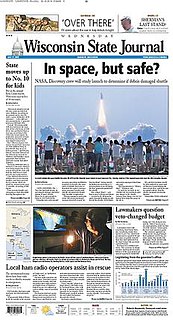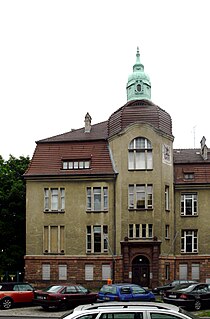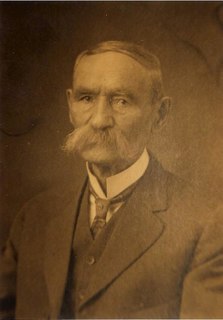
Madison is the capital of the U.S. state of Wisconsin and the seat of Dane County. As of July 1, 2018, Madison's estimated population of 258,054 made it the second-largest city in Wisconsin by population, after Milwaukee, and the 81st-largest in the United States. The city forms the core of the Madison Metropolitan Area which includes Dane County and neighboring Iowa, Green, and Columbia counties for a population of 654,230.
Menomonee Falls is a village in Waukesha County, Wisconsin, United States, and is part of the Greater Milwaukee area. The population was 35,626 at the 2010 census, making it the most populous village in Wisconsin. It is the fourth largest community in Waukesha County.

John Coit Spooner was a politician and lawyer from Wisconsin. He served in the United States Senate from 1885 to 1891 and from 1897 to 1907. A Republican, by the 1890s, he was one of the "Big Four" key Republicans who largely controlled the major decisions of the Senate, along with Orville H. Platt of Connecticut, William B. Allison of Iowa and Nelson W. Aldrich of Rhode Island.

The Wisconsin State Journal is a daily newspaper published in Madison, Wisconsin by Lee Enterprises. The newspaper, the second largest in Wisconsin, is primarily distributed in a 19 county region in south-central Wisconsin. As of September 2018, the Wisconsin State Journal had an average weekday circulation of 51,303 and an average Sunday circulation of 64,820.

Rasmus Bjørn Anderson was an American author, professor, editor, businessman and diplomat. He brought to popular attention the fact that Viking explorers were the first Europeans to arrive in the New World and was the originator of Leif Erikson Day.

Breese Stevens Municipal Athletic Field is a multi-purpose stadium in Madison, Wisconsin. Located eight blocks northeast of the Wisconsin State Capitol on the Madison Isthmus, it is the oldest extant masonry grandstand in Wisconsin.

The Badger State Trail is a 40-mile (64 km) rail trail in south central Wisconsin. The trail leads from the Wisconsin – Illinois state line to Madison passing through, from south to north, Monroe, Monticello, Belleville and Fitchburg. Near Monticello, the trail passes through the 1,200-foot (370 m) long, unlit Stewart Tunnel constructed in 1887. The trail was officially opened July 8, 2007.

Equine nutrition is the feeding of horses, ponies, mules, donkeys, and other equines. Correct and balanced nutrition is a critical component of proper horse care.

Beet pulp is a byproduct from the processing of sugar beet which is used as fodder for horses and other livestock. Beet pulp is the fibrous material left over after the sugar is extracted from sugar beets. It is supplied either as dried flakes or as compressed pellets, but when fed to horses it should always be soaked in water first.
Benjamin Franklin Hopkins was an American politician and telegraph operator. He was a member of the United States House of Representatives for the last three years of his life. Earlier he had served one term each in the Wisconsin State Senate and Wisconsin State Assembly, and had worked as a private secretary to Wisconsin Governor Coles Bashford.

The University of Wisconsin–Madison is a public research university in Madison, Wisconsin. Founded when Wisconsin achieved statehood in 1848, UW–Madison is the official state university of Wisconsin, and the flagship campus of the University of Wisconsin System. It was the first public university established in Wisconsin and remains the oldest and largest public university in the state. It became a land-grant institution in 1866. The 933-acre (378 ha) main campus, located on the shores of Lake Mendota, includes four National Historic Landmarks. The university also owns and operates a historic 1,200-acre (486 ha) arboretum established in 1932, located 4 miles (6.4 km) south of the main campus.
George Baldwin Smith was an American politician and lawyer. He was the 4th Attorney General of Wisconsin, and the 3rd and 16th Mayor of Madison, Wisconsin.

The Sugar Museum in Berlin, devoted to the history and technology of sugar, is the oldest such museum in the world, having opened in 1904. It is now part of the German Museum of Technology. Until November 2012, it was housed in the Institut für Lebensmitteltechnologie in Wedding, Mitte.

Kremlin is an unincorporated community located in the town of Pembine, Marinette County, Wisconsin, United States.
Joel Cook Squires was a carpenter and miner who served as a member of the Wisconsin State Senate for two years from two different districts, and of the Wisconsin State Assembly for one term.

The California Beet Sugar Company was the first sugar beet factory in the United States. It was located in Union City, California and its site is on the California Historical Landmarks list.
Buel Eldridge Hutchinson was an American politician and lawyer.
Michael Olbrich was a Madison, Wisconsin, lawyer, politician, and conservationist, who founded Olbrich Botanical Gardens and the University of Wisconsin-Madison Arboretum.

David Richard Jones was a Welsh-American architect and poet.
Gideon Winans Allen, was a member of the Wisconsin State Assembly.

















